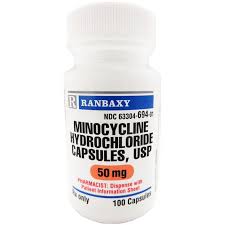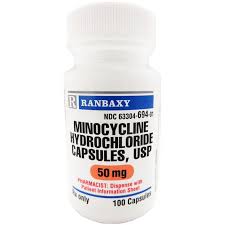Providing Quality & Trust || Clinic Website
Minocycline Capsule
No Info
$0.40 - $60.80
$0.40 Each
Detailed Description
Minocycline
(mi-noe-sye-kleen)
- Description: Tetracycline Antibiotic
- Other Names for this Medication: Minocin®, Solodyn®
- Common Dosage Forms: Veterinary: None.
- Antimicrobial Classification: Highly Important
Oral minocycline products can be given with or withoutfood. Milk or other dairy products do not significantly affectthe amount of minocycline absorbed. Do not give as a dry pill. Minocycline should be given with a moisttreat or small amount of liquid to ensure the medication reaches the stomach (especially importantfor cats).
Minocycline may cause ulcers in the throat and esophagus if it gets stuck there before itreaches the stomach. If your animal has trouble swallowing or eating, contact your veterinarian immediately. If your animal vomits or acts sick after receiving the drug on an empty stomach, try giving the next dose with food or a small treat. If vomiting continues, contact your veterinarian. Do not give antacids including sucralfate, oral iron, or antidiarrheal medicines within 2 hours before or after giving minocycline. These products will reduce its effectiveness.
This drug may make your animal’s skin more sensitive to sunlight and increase the risk for sunburn on hairless areas (eg, nose, around eyelids and ears). Tell your veterinarian if you notice any reddening (sunburn) on the skin while your animal is on this medication.
How is this medication useful?
Minocycline is an antibiotic used to treat certain bacterial infections. The FDA (U.S. Food & Drug Administration) has approved this drug for use in humans, butitis not officially approved for use in animals. The FDA allows veterinarians to prescribe products containing this drug in different species or for other conditions in certain situations.
You and your veterinarian can discuss why this drug is the most appropriate choice.
Uses/Indications:
Minocycline is a tetracycline-family drug that may be used in the treatment of a variety of bacterial infections, particularly when doxycycline is unavailable. It can be effective against some doxycycline-resistant staphylococci. Minocycline is not a good choice for the treatment of UTIs, as it has diminished urinary excretion as compared with doxycycline.
In a study, minocycline was effective in the treatment of periodontitis in dogs when applied locally after scaling and root planing were performed. Minocycline purportedly has antiangiogenic effects but was ineffective as adjuvant therapy when given to dogs with hemangiosarcoma treated with standard chemotherapy.
Minocycline has been suggested as a potential alternative to doxycycline in the treatment of Lyme disease (ie, Borrelia burgdorferi) in horses. Minocycline is also likely to be effective in the treatment of Lyme disease in dogs, but studies are needed to confirm this suggestion.
The World Health Organization (WHO) has designated minocycline as a Highly Important antimicrobial in human medicine.
What are the side effects of this medication?
Side effects that usually are not serious include:
- Vomiting and reduced appetite. If any of these signs occur, try giving the next dose with a small amount of food to see if it helps.
- Diarrhea.
- Reddening (sunburn) of hairless skin around nose, eyelids, and ears when exposed to sunlight.
You don’t have to be overly concerned if you see any of these signs unless they are severe, worsen, or continue to be a problem. Contact your veterinarian if this happens.
Side effects that may be serious orindicate a serious problem:
- Lack of energy, weakness, or lack of an appetite could indicate bone marrow toxicity (rare).
- Vomiting; severe or bloody diarrhea; loss of appetite; yellowing of eyes, skin, or gums (jaundice); bleeding; seizures (convulsions); or severe changes in behavior.
- Loss of appetite, vomiting, regurgitation, or trouble swallowing may indicate damage to the throat or esophagus has occurred from the medication getting stuck on the way to the stomach.
If you see any of these signs, contact your veterinarian immediately.
Contraindications/Precautions/Warnings:
Minocycline is contraindicated in patients that are hypersensitive to tetracyclines, pregnant or nursing, or younger than 6 months. Minocycline is much less likely to cause these abnormalities than other more water-soluble tetracyclines (eg, oxytetracycline, tetracycline). Unlike either oxytetracycline or tetracycline, minocycline can be used in patients with moderate renal insufficiency without dosage adjustment; however, patients with oliguric renal failure may require dosage adjustment.
Because urine levels are low, minocycline is not recommended in the treatment of UTIs.
For oral use of minocycline in cats, the doxycycline recommendations for administration should be followed to reduce the risk for oroesophageal erosions. In the use of oral tablets or capsules, pilling should be followed by at least 6 mL of water or food. Dry pilling should not be performed.
Adverse Effects:
The most commonly reported adverse effects of oral minocycline in dogs and cats are nausea and vomiting. To alleviate these effects, the drug could be given with food. Dental or bone staining can occur when minocycline exposure occurs in utero or early in life. More rarely, increases in hepatic enzymes and/or ototoxicity are possible. Two research cats (50%) became lethargic and tachypneic after IV administration, and vomiting occurred in 3 (≈30%) cats.
Similar to doxycycline, oral minocycline can cause esophagitis and esophageal strictures in cats. See Contraindications/Precautions/Warnings for more information.
IV injections of minocycline in dogs have caused urticaria, shivering, hypotension, dyspnea, cardiac arrhythmias, and shock when given rapidly; IV administration should be done slowly.
Tetracycline therapy—especially long-term—may result in overgrowth (ie, superinfections) of nonsusceptible bacteria or fungi.
In humans, minocycline (or other tetracyclines) has also been associated with photosensitivity reactions and, rarely, hepatotoxicity or blood dyscrasias. CNS effects (eg, dizziness, lightheadedness) are commonly reported in humans taking minocycline. A blue-gray pigmentation of skin and mucous membranes may occur.
Drug Interactions:
The following drug interactions have either been reported or are theoretical in humans or animals receiving minocycline and may be of significance in veterinary patients. Unless otherwise noted, use together is not necessarily contraindicated, but the potential risks should be weighed and additional monitoring performed when appropriate.
- ANTACIDS, ORAL: When orally administered, tetracyclines can chelate divalent or trivalent cations and decrease the absorption of the tetracycline or another drug if it contains these cations. Oral antacids, saline cathartics, and other GI products containing aluminum, calcium, magnesium, zinc, and/or bismuth cations are most commonly associated with this interaction. Minocycline has a relatively low affinity for divalent or trivalent cations, but it is recommended that all oral tetracyclines be given at least 1 to 2 hours before or after the cation-containing product.
- BISMUTH SUBSALICYLATE, KAOLIN, PECTIN: May reduce absorption of minocycline
- DIGOXIN: Concurrent use with minocycline may cause digoxin toxicity. These effects may persist for months after discontinuation of the tetracycline.
- IRON, ORAL: Oral iron products are associated with decreased tetracycline absorption, and iron salts should preferably be given 3 hours before or 2 hours after the tetracycline dose.
- PENICILLINS: Bacteriostatic drugs (eg, tetracyclines) may interfere with the bactericidal activity of penicillins, cephalosporins, and aminoglycosides; however, there is a fair amount of controversy regarding the actual clinical significance of this interaction.
- RIFAMPIN: Synergistic activity against Rhodococcus equi in foals may occur.
- SEVOFLURANE: In a study of rats, minocycline reduced isoflurane MAC requirement by 23%.
- SUCRALFATE: Significantly decreases the oral bioavailability of minocycline in healthy dogs. Administration 2 hours after minocycline did not have a significant impact on absorption of minocycline.
- VITAMIN A: May result in an increased risk for pseudotumor cerebri
- WARFARIN: Tetracyclines may depress plasma prothrombin activity; patients on anticoagulant therapy may need dosage adjustment.
Storage/Stability:
Store oral preparations at room temperature in tight containers. Do not freeze oral suspensions. The injectable should be stored at room temperature (ie, 20°C-25°C [68°F-77°F]) and protected from light, moisture, and excessive heat. After reconstitution with sterile water for injection, solutions with a concentration of 20 mg/mL are stable for 4 hours at room temperature or for 24 hours if refrigerated.

Powered by nopCommerce
This site is running in live payment mode. Real payments will be processed.

